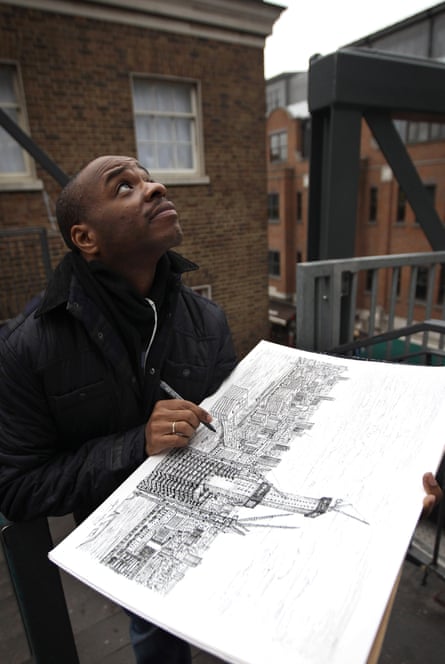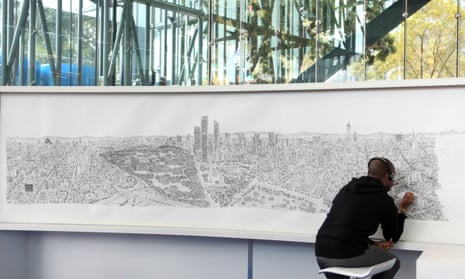Stephen Wiltshire’s meticulously detailed panoramas are so intricate that you would be forgiven for thinking that he spent weeks closely studying the architecture of our cities. His work becomes all the more impressive when you discover that Wiltshire gazes at an urban vista just once to memorise it.
Sometimes, he takes a whistle-stop tour of a city’s skyline by helicopter, only to produce a finished impression in a matter of days. A 2001 BBC documentary showed him completing a complex but perfectly scaled aerial illustration of London – with 12 historic landmarks and 200 other buildings – in three hours.
He works rapidly, with headphones in, his pencil skimming the surface of the canvas (some of the larger panoramic canvases are curved and span 13ft), and using the finger of his other hand for perspective. He then goes over the sketches in pen, filling in the details of the buildings, and a city emerges before your eyes.
His sister Annette Wiltshire has described watching him work as like watching fine embroidery – each dart of the pen is a stitch in the intricate tapestry. His drawings – which also show New York, Paris, Moscow, Venice, Edinburgh and Amsterdam – sell for thousands of pounds to clients all over the world.
It feels a shame to mention that Wiltshire has an autism diagnosis, because he deserves to be seen as an artist in his own right, regardless of his condition. Indeed, the gallery he works with in central London are keen to stress that his autism is not the most notable thing about him, saying, “we wish to highlight his creative talent and focus on purely artistic context only,” – though it is mentioned in the press documents about his work.
“Stephen has no understanding of autism,” adds Annette. “However he does understand that he is an artist, an artist in his own right and [should] not be labelled with this title. It’s important to concentrate on his talent and how he has overcome his hurdles.”

And while early media appearances – like this one on BBC’s QED series in 1986 – focused on his autism, over the years the decision was made by his family to align Wiltshire’s profile with his own self-perception. “Stephen chose to profile himself this way because he sees himself as an artist,” says Annette. Which he is: he has a PhD in drawing and printmaking from the City & Guilds of London Art School, and in 2006 he was awarded an MBE for services to art.
But Wiltshire’s autism is of note, if only to highlight his precocious development as a highly talented artist. “I started drawing at the age of three, as communication was not an option for me at the time until the age of five, so this was my form of language,” he says through Annette, who interviewed him on my behalf.
His first words were paper and pencil. At primary school, his teachers used his interest in drawing as a way of encouraging him to communicate; one in particular took him out on drawing excursions and entered his work in competitions. He flourished.
“I first started having an interest in cities and buildings when I was around seven or eight years old,” he says. “I always liked high-rise buildings, the many windows and lots of details. I particularly like how it can change the skyline when new developments are added over the years.” Once, he says, he watched a hospital “get bulldozed down … intrigued to know what would be built afterwards”.
The artist sold his first picture for £1,500 at the age of seven, and has since been in high demand. A career highlight remains his first visit to New York when he was 13, a city he loves and often visits. “It’s such a great city, so many skyscrapers, it’s intense and busy, a lot of things happening in one go, full of buzz and excitement.”
It was there where he met the late author and neurologist Oliver Sacks. The two became lifelong friends, and Sacks wrote extensively about him. “His limitations, paradoxically, can serve as strengths, too,” Sacks wrote in the New Yorker in 1995. “His vision is valuable, it seems to me, precisely because it conveys a wonderfully direct, unconceptualised view of the world.”
Personally, I disagree: I see interpretation throughout his work. Despite the detail there is often a sketchy, figurative quality to his images that verges on cartoon-like. The artist he most admires is Richard Estes, but his own style is nowhere near as photorealistic; Wiltshire’s personality is present in his drawings.
The best cityscape artists capture something of the place that is not necessarily tangible: Yvonne Jacquette lends New York a twilight glamour, while Frans Koppelaar renders an Amsterdam of muted, mousy gloom. LS Lowry’s industrial Manchester is a playful stage for the matchstick people in the foreground. Wiltshire, for his part, works frequently in monochrome, stripping the architecture back to its bare bones while retaining a sense of the city’s character.
Of New York – his “spiritual home” – he says: “I love the chaos and the order of the city at the same time, the rush hour traffic v the square avenues.” But he also draws the classic and intricate architecture of Venice and Cologne. The most challenging city to draw, he says, was Amsterdam, because of the many details he had to remember in such a short space of time (as well as the names of the buildings, which were difficult to retain).
In 2005, he was commissioned by a range of companies and private collectors to undertake vast panoramic drawings of 10 world cities starting with a 10m-long drawing of the Tokyo skyline, then Hong Kong, Rome, Frankfurt, Madrid, Dubai, Jerusalem, London and New York. He is keen to visit Montreal, Canada, which he is yet to draw.
The best thing about his success, Wiltshire says, is all the people he gets to meet. Wherever he works, people stop agape to watch him draw. In Singapore, he had 150,000 visitors to his gallery and live performance space in just five days.
“It makes me feel good and happy because it makes people smile, when they smile I smile. I also like going up in the helicopter and seeing the cityscape from a bird’s eye view.”
“Most autists are not artists,” Sacks wrote, “as most artists are not autists.” The fascination with “savants” adds little to our interpretation of Wiltshire’s work, except perhaps a hint at the unique cognitive processes at play. Similarities can be seen with Gilles Trehin, the French architectural artist who also happens to be autistic, though his cities are wholly imaginary. But the value is not in the biography of the artist, but in the art itself.
“Stephen may be … autistic,” Sacks wrote, “but it is given him to achieve what few of us do, a significant representation and investigation of the world.”
Follow Guardian Cities on Twitter and Facebook to join the discussion, and explore our archive here

Comments (…)
Sign in or create your Guardian account to join the discussion